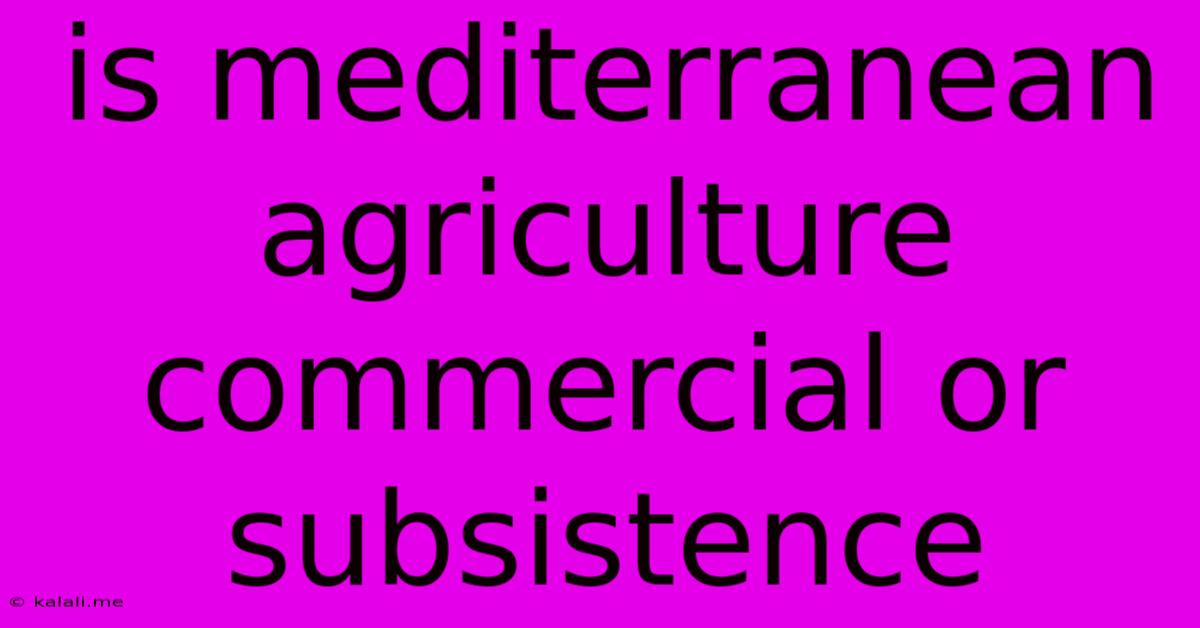Is Mediterranean Agriculture Commercial Or Subsistence
Kalali
Jun 13, 2025 · 3 min read

Table of Contents
Is Mediterranean Agriculture Commercial or Subsistence? A Complex Reality
Mediterranean agriculture is a fascinating blend of commercial and subsistence practices, defying easy categorization. While the dominant image might be one of sprawling olive groves and vineyards producing export-quality goods, the reality is far more nuanced. This article explores the diverse landscape of Mediterranean farming, examining the interplay between commercial and subsistence activities and the factors influencing their prevalence.
A Balancing Act: Commercial and Subsistence Farming in the Mediterranean
The Mediterranean region encompasses a vast array of environments, climates, and socio-economic conditions. This diversity translates into a wide spectrum of agricultural practices, blurring the lines between purely commercial and purely subsistence farming. In many areas, farmers engage in both simultaneously, creating a complex and often intertwined system.
Factors Favoring Commercial Agriculture:
-
Favorable Climate and Terrain: Certain areas within the Mediterranean basin boast ideal conditions for cultivating high-value crops like grapes, olives, citrus fruits, and almonds, making large-scale commercial production economically viable. These areas often experience favorable sunlight, mild winters, and sufficient rainfall (though irrigation is frequently employed). Efficient irrigation techniques further enhance commercial viability.
-
European Union Agricultural Policies: Subsidies and support mechanisms from the EU have significantly impacted the agricultural landscape of Mediterranean countries, encouraging the expansion of commercial farming and export-oriented production. These policies often prioritize large-scale operations, potentially marginalizing smaller subsistence farms.
-
Globalization and Market Demand: The increasing global demand for Mediterranean products like olive oil, wine, and citrus fruits fuels commercialization. Modern transportation and logistics networks allow for efficient distribution to international markets, bolstering the profitability of commercial agriculture. Increased consumer awareness of the health benefits of Mediterranean diet components further enhances market demand.
Factors Favoring Subsistence Agriculture:
-
Challenging Terrain and Resource Limitations: Many regions within the Mediterranean basin face limitations like steep slopes, rocky terrain, and water scarcity, making large-scale commercial agriculture impractical or uneconomical. In these areas, subsistence farming, focused on family needs, remains prevalent. Traditional farming methods, adapted to the local environment and resource constraints, continue to be practiced.
-
Cultural and Traditional Practices: In certain communities, traditional farming practices, handed down through generations, remain deeply rooted. These practices often prioritize self-sufficiency and food security over maximizing market profits. Local varieties of crops, often better adapted to challenging environmental conditions, are preserved.
-
Limited Access to Resources and Markets: Smallholder farmers often lack access to credit, modern technology, and efficient marketing channels, limiting their ability to fully participate in commercial agricultural markets. This is particularly true in remote and less developed areas. Furthermore, limited infrastructure can restrict access to export markets.
The Interplay and Future of Mediterranean Agriculture:
The future of Mediterranean agriculture is likely to see a continued interplay between commercial and subsistence practices. While globalization and market forces push towards commercialization, the inherent limitations of the environment and the importance of cultural traditions will continue to sustain subsistence farming in many areas.
Strategies for Sustainable Coexistence:
- Sustainable intensification: Improving the efficiency and productivity of existing farmland without expanding its area.
- Agroecology: Integrating ecological principles into farming practices to enhance biodiversity, resilience, and sustainability.
- Support for smallholder farmers: Providing access to credit, training, and market opportunities to enable small farms to thrive.
- Preservation of traditional farming practices: Recognizing and valuing the contribution of traditional knowledge and local varieties.
In conclusion, characterizing Mediterranean agriculture as solely commercial or subsistence is a simplification. The reality is a vibrant tapestry woven from both, shaped by a complex interplay of environmental, economic, and social factors. Understanding this nuanced reality is crucial for developing sustainable and equitable agricultural policies for the region.
Latest Posts
Latest Posts
-
Discounting Is The Opposite Of
Jun 14, 2025
-
The Unit Of Measure For Capacitive Reactance Is The
Jun 14, 2025
-
A Set Of All Possible Outcomes Is Known As
Jun 14, 2025
-
What Are The Prime Factors Of 47
Jun 14, 2025
-
Which Ocean Separates Europe And North America
Jun 14, 2025
Related Post
Thank you for visiting our website which covers about Is Mediterranean Agriculture Commercial Or Subsistence . We hope the information provided has been useful to you. Feel free to contact us if you have any questions or need further assistance. See you next time and don't miss to bookmark.